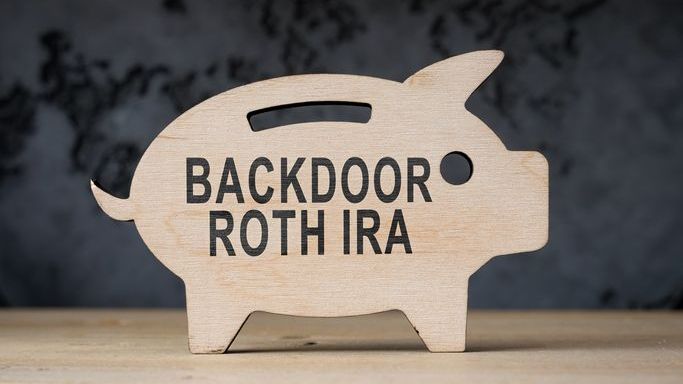A backdoor Roth conversion can save you significantly in future taxes, but at the cost of paying those taxes now. This isn’t always a good deal in the long run.
If you’re considering a backdoor Roth IRA or other strategies to save on taxes, consider talking it over with a financial advisor.
For example, perhaps you’re married with a combined income of $400,000 per year, putting you and your spouse well above the income limits for contributing to a Roth IRA. However, you can still build an after-tax retirement account by contributing to a traditional IRA and then converting it to a Roth account. This strategy, known as the backdoor Roth IRA, will lead to tax-free withdrawals in retirement but higher income taxes in the years in which the conversions are made.
Roth IRA Contribution Limits
A Roth IRA is a retirement account that’s funded with after-tax contributions. This means that you don’t get any special tax breaks on the money that you contribute. You instead pay taxes on the money up front, before it goes into the account, in exchange for tax-free growth from then on.
This can make Roth portfolios extremely valuable under the right circumstances. For example, say that you contribute $100 to your Roth IRA and it grows to $1,000 by the time you retire. You would have paid taxes on the $100 contribution in exchange for $900 worth of tax-free gains. This is especially the case for someone who expects to be in a higher tax bracket in retirement.
However, the IRS has strict contribution and income limits for Roth IRAs. Annual contributions are capped at $7,000 in 2024 ($8,000 for people 50 and older) – significantly less than the $23,000 you can save in a 401(k) or similar account. These annual limits apply to all IRAs, meaning you can only contribute up to a combined $7,000 in 2024 to your IRAs, regardless of how many traditional and Roth accounts you own.
Roth IRAs also have income limits. In 2024, if your modified adjusted gross income (MAGI) is below $146,000 as an single filer or $230,000 as a married couple filing jointly, you may contribute up to $7,000. However, single filers with a MAGI between $146,000 and $161,000 and married couples with a MAGI between $230,000 and $240,000 can only make a partial Roth contribution. Households earning more than these caps lose the ability to contribute to a Roth IRA altogether.
Consider speaking with a financial advisor if you need guidance on strategically spreading your retirement savings across traditional and Roth IRAs.
What Is a Backdoor Roth?

The IRS offers a legal loophole for circumventing the Roth contribution and income limits, though.
Contributing directly to a Roth IRA isn’t the only way to harness an after-tax retirement account. You can also convert tax-deferred assets held in a traditional IRA or 401(k) into Roth assets by paying income taxes on the money and rolling it over into a Roth IRA. There are no income limits for this backdoor conversion process, allowing high-income households to fund Roth accounts.
For example, say that you and your spouse together earn $400,000 per year, making you ineligible to contribute directly to a Roth IRA.
However, you could each contribute $7,000 to your traditional IRAs and then roll the money over into Roth IRAs, paying taxes on the money that year. You could do this once a year (ideally on January 1 to maximize untaxed gains) or carry out a series of conversions throughout the year. You could also each contribute $23,000 to your 401(k)s and roll that money over, too, giving you a combined $60,000 in annual Roth IRA contributions regardless of income.
If you want to speak with an expert about the backdoor Roth strategy or others, this tool can match you with financial advisors who serve your area.
Should You Build a Backdoor Roth?

A backdoor Roth gives high-income households access to a post-tax portfolio, but it comes at a cost. Literally.
When you convert funds into a Roth IRA, you add the total amount that’s converted to your taxable income for the year. For example, if you and your spouse each converted $30,000, together you would pay taxes on the full $60,000, eliminating the tax advantages of making pre-tax contributions. For high-earners who likely are in higher tax brackets already, this can add significant costs.
This all can make a backdoor Roth complicated, says Tim Maurer, chief advisory officer at the wealth management firm Signature FD.
“There is an argument to be made that high-earning individuals would benefit more from deductible forms of retirement savings because their income tax bracket is likely higher today than it will be when they are in retirement,” he said. “However, there are always considerations beyond the singular factor of where taxes are today and where they may be in the future.”
For one thing, Maurer added, it’s always important to remember that tax planning is heavily predictive. While we know what the brackets are today, we can’t necessarily know what rates will be in five, 10 or 20 years. Tax rates could rise between now and when you retire, making a Roth IRA more valuable with each tick upward.
And don’t forget that the rules can always change, he said. While the backdoor Roth is a well-established loophole, there have been legislative efforts to close it in the past. Since every dollar in a Roth IRA is worth more than an equivalent dollar in a pre-tax account, that argues for taking advantage of the opportunity while you have it.
So, what should you do?
“As is often the case in the uncertain world of financial planning, instead of betting wholly on one strategy or the other, the optimal course often calls for Solomonic wisdom and diversification,” Maurer said.
“For high earners, it still likely makes sense to maximize tax deductibility through 401(k)s … [T]hen, to the degree that it is palatable, consider a reasonable amount of Roth conversions during your working years to ensure tax-free dollars are accessible to you (or your heirs) in retirement,” he added.
Finally, Maurer suggested that you can consider making larger conversions in your first few years of retirement. Your income and taxes will likely have dropped, which would make it easier to convert more money at a lower rate. But if you need help figuring out when might be the optimal time for a Roth conversion, consider connecting with a financial advisor to talk about it.
Bottom Line
For high-earning households, a backdoor Roth can give you access to tax-free withdrawals in retirement. The catch, however, is that it can come at particularly high costs now and may outweigh the potential benefits. A prudent strategy may be to convert only a portion of your retirement savings. Doing so can allow you to capitalize on the tax benefits of contributing to a traditional IRA while also preserving some of the flexibility that a Roth IRA can provide later on.
Tips for Building Your Roth IRA
- SmartAsset’s retirement calculator can help you project how much money you’ll need to retire, as well as how much post-income your current savings and Social Security may generate. However, that number could be significantly higher if your savings are in a Roth account.
- A financial advisor can help you build a comprehensive retirement plan. Finding a financial advisor doesn’t have to be hard. SmartAsset’s free tool matches you with up to three vetted financial advisors who serve your area, and you can have a free introductory call with your advisor matches to decide which one you feel is right for you. If you’re ready to find an advisor who can help you achieve your financial goals, get started now.
Photo credit: ©iStock.com/Liubomyr Vorona, ©iStock.com/designer491, ©iStock.com/dragana991